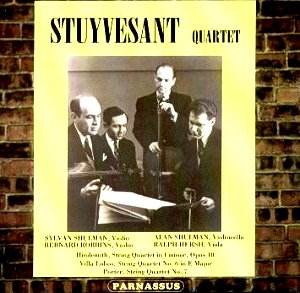Full marks to Parnassus for this. Not only do we have
the Hindemith Op. 10 originally released on a 10" Philharmonia
LP and the equally elusive Villa-Lobos, which made a 78rpm appearance
on International Records but we have the previously unpublished Quincy
Porter taken from a set of transcription discs of a concert performance.
This is the kind of presentation, performance and repertoire I like
and it has all been splendidly well done, down to the booklet picture
of the Stuyvesant Quartet as a mock poster cum record cover, plastered
onto a red brick wall.
Admirers of the great American Quartets of the 1930s-1950s
will spring to attention when they hear the name Stuyvesant.
Yes, others were as prominent if not more so – the Coolidge, the Gordon,
Curtis, Musical Arts, Paganini, the transplanted Guilet and London,
the Stradivarius and plenty of others – but the Stuyvesant always sought
out creative and imaginative repertoire and their changing personnel
were some of the very best around. At this time the composition of the
quartet was Sylvan Shulman and Bernard Robbins, violins, Ralph Hersh,
viola and Alan Shulman, cello. They bring out the unexpectedly generous
romanticism of the Hindemith with expressive depth, Hersh’s viola sounding
strongly. In the second movement, a theme and variations, the writing
for first violin is full of lyrical heights with the Stuyvesant observing
dynamic markings with acute sensitivity. There is a real sense of joyous
freedom in the free-moving Finale, a complex, evolutionary and formally
odd one with moments of introspective withdrawal deeply imbedded into
its syntax.
The rhythmic suspensions and mini dramas in Villa-Lobos’s
Sixth Quartet, its twisting lines with single voices set against syncopations
are all marvellously done. The Allegretto is especially evocative with
the three strings playing pizzicati behind the cello’s solo and following
it a repeat, this time for first violin and pizzicati trio. Villa-Lobos
explores the formal parameters of conventional quartet writing, here
using pizzicati as rhythmic plasticine to mould convincing sonority
and drive, a dancing vitality conveyed through new means. The Andante
is indeed elliptical – the notes referring to a subdued second violin
line – but it lasts a full seven minutes and not the three stated -
so it possesses a coherence of its own, an independence and a tangential
one at that, and doesn’t really serve at all as an introduction to the
finale as claimed. This is a driving and dance based movement, full
of sonority and rhythmic grip.
The Quincy Porter was recorded in concert at Town Hall,
New York in February 1948. There would have been few enough opportunities
to acquaint oneself with his works on disc. Porter, a good string player,
had recorded his own Viola Suite and the Gordon Quartet had essayed
his Third Quartet; there were also some anonymous performances of Porter’s
theatre music, Sixth Quartet and Flute Quintet on the obscure Yaddo
label (anyone know anything about these?). There are a few clicks and
some extraneous noises with swishes but nothing at all to mar or obscure
listening. This is a compact three-movement work written in 1943 and
premiered by the Coolidge Quartet. His own brand of sonata form is impressive
and the constant rhythmic inflections co-exist with moments of real
lyrical surge – melodies seem sometimes to be extracted forcibly from
the texture of the music and in the first movement little perky melodic
themes swirl about like glitter dust. All four players consciously adjust
depth of vibrato usage in the beautiful slow movement before unleashing
a finale notable for Porter’s clever manipulation of form and rhythm,
teasing and precise and successful.
Throughout the Stuyvesant are compelling guides, instrumentally
equal to all demands, impeccably eloquent in matters of internal balance
and equalization, and acutely sensitive to colour and weight and rhythm.
I loved them.
Jonathan Woolf
See also review
by Rob Barnett
